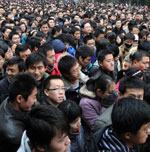
 China's urban population stands at more than 600 million  FRONT PAGE Site Search About us     Urban population growth from now to 2030 World's largest cities and their mayors 2011 World's largest cities 2007 Capital cities Largest cities in the world Largest urban areas Largest European cities Largest US cities Largest Canadian cities Largest Brazilian cities Largest German cities Largest French cities Largest French urban areas Largest UK cities Largest Italian cities Largest Spanish cities Largest Indian cities Largest Japanese cities EIU: Best cities in the world Mercer: Best cities in the world Most expensive cities in the world Richest cities in the world Urbanisation 2008 to 2030  Worldwide | Elections | North America | Latin America | Europe | Asia | Africa |                            |
Urban population growth
|
|
Country
|
1950
Urban population as percentage of total |
2010
Urban population as percentage of total |
2030
Urban population as percentage of total (Estimate) |
| Argentina |
65.3
|
92.4
|
93.2
|
| Australia |
77.0
|
89.1
|
91.9
|
| Bangladesh |
4.2
|
28.1
|
39.9
|
| Brazil |
36.2
|
86.5
|
91.1
|
| Canada |
60.9
|
80.6
|
84.4
|
| Chile |
58.4
|
89.0
|
92.3
|
| China |
13.0
|
44.9
|
60.3
|
| Egypt |
31.9
|
42.8
|
53.9
|
| Ethiopia |
4.6
|
17.6
|
27.1
|
| Finland |
31.9
|
63.9
|
68.9
|
| France |
55.2
|
77.8
|
82.9
|
| Germany |
64.7
|
73.8
|
80.0
|
| India |
17.0
|
30.1
|
40.7
|
| Indonesia |
12.4
|
53.7
|
68.9
|
| Iran |
27.5
|
69.5
|
77.9
|
| Israel |
71.0
|
91.7
|
93.0
|
| Italy |
54.1
|
68.4
|
74.6
|
| Kenya |
5.6
|
22.2
|
33.0
|
| South Korea |
21.4
|
81.9
|
86.3
|
| Malaysia |
20.4
|
72.2
|
81.9
|
| Mexico |
42.7
|
77.8
|
82.8
|
| Netherlands |
56.1
|
82.9
|
88.6
|
| Nigeria |
11.6
|
49.8
|
66.0
|
| Pakistan |
17.5
|
37.0
|
49.8
|
| Philippines |
27.1
|
66.4
|
76.7
|
| Poland |
38.3
|
61.2
|
70.0
|
| Portugal |
31.2
|
60.7
|
71.4
|
| Russia |
44.2
|
72.8
|
75.7
|
| Saudi Arabia |
21.3
|
83.6
|
86.2
|
| South Africa |
42.2
|
61.7
|
71.3
|
| Sweden |
65.7
|
84.7
|
83.1
|
| Switzerland |
44.3
|
73.6
|
83.1
|
| Syria |
30.6
|
54.9
|
61.0
|
| Thailand |
16.5
|
34.0
|
45.8
|
| Turkey |
24.8
|
69.6
|
77.7
|
| UK |
79.0
|
90.1
|
92.2
|
| USA |
64.2
|
82.3
|
87.0
|
| Venezuela |
46.8
|
94.0
|
97.1
|
| Vietnam |
11.6
|
28.8
|
42.8
|
Table 2: Urban population in 122 countries together with their largest cities
Table 3: Countries with the largest number of people living in urban areas
Table 4: Countries with the highest proportion of people living in urban areas
Follow @City_Mayors
